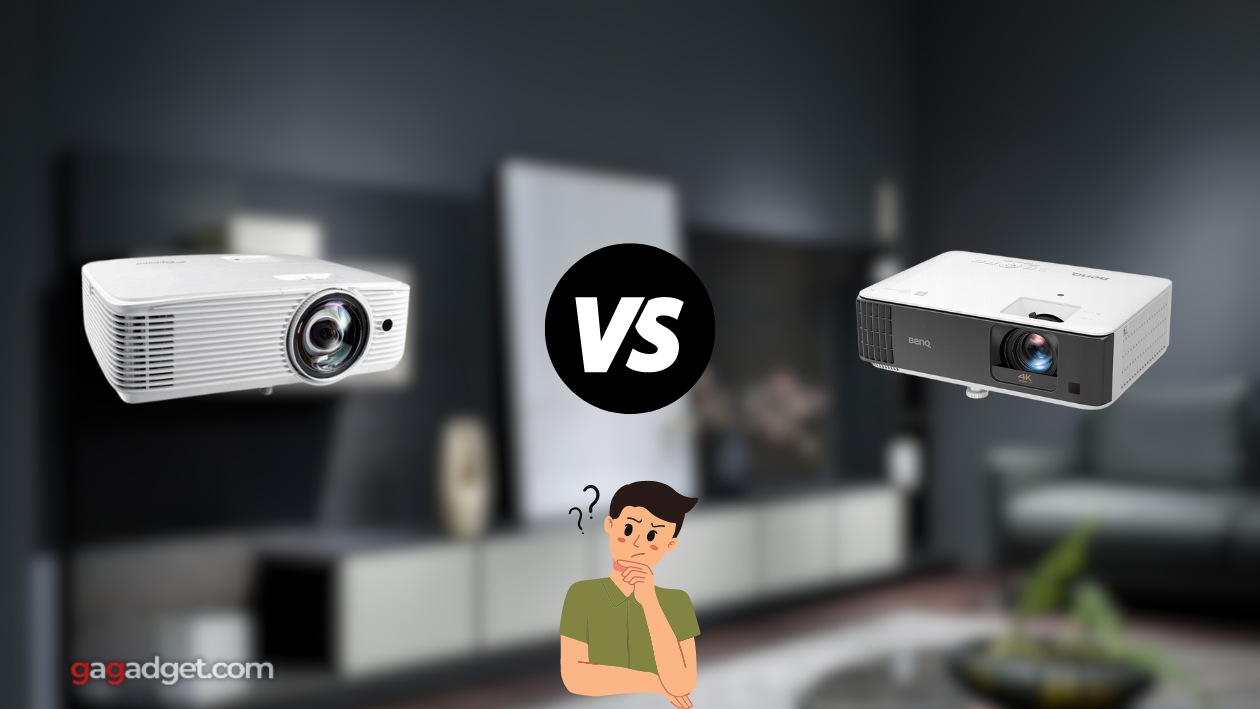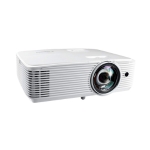At gagadget.com, your trust is our priority. We follow strict quality standards in our research, tests, and analysis of video projectors, to give you the best experience. Learn more
Optoma GT1080HDR vs Benq TK700STi
Hey everyone, it's Jim from Gagadget. Today, I'm comparing two powerhouse gaming projectors: the Optoma GT1080HDR and BenQ TK700STi. Both are built to deliver lightning-fast response times, high brightness, and immersive visuals for the ultimate big screen gaming experience. But they also have some key differences in resolution, throw ratio, and smart features that could make one a better fit for your particular setup and preferences.
I've spent many hours hands-on with both projectors, scrutinizing image quality, measuring input lag, tweaking settings, and of course, fragging enemies on 100"+ screens. In this in-depth GT1080HDR vs TK700STi face-off, I'll break down how these two gaming beasts compare in the categories that matter most. Let's get ready to rumble!

Optoma GT1080HDR vs BenQ TK700STi: Quick Overview
If you're in a hurry, here's the quick rundown: The Optoma GT1080HDR and BenQ TK700STi are both single-chip DLP projectors designed for gaming. They support fast refresh rates of 120Hz or higher for smooth motion and minimal input lag under 20ms. The GT1080HDR is slightly brighter at 3,800 lumens vs the TK700STi's 3,000 lumens. The big difference is resolution - the TK700STi features native 4K UHD while the GT1080HDR tops out at 1080p (with 4K input support). The BenQ also has a larger zoom range, lens shift, and Android TV streaming built-in.
For serious gamers after the ultimate level of clarity, I recommend the BenQ TK700STi. The razor-sharp 4K resolution and 1.2x zoom offer a revealing, breathtaking picture you can dial in just right. But if you mostly play fast-twitch shooters or want maximum brightness and a shorter throw, the Optoma GT1080HDR's 1080p/120Hz mode, 3,800 lumens, and 0.50 throw ratio are tough to beat. Your move!
Table of Contents
- Optoma GT1080HDR vs BenQ TK700STi: Full Comparison
- TK700STi vs GT1080HDR: Design
- Optoma GT1080HDR or BenQ TK700STi: User Reviews
- Optoma GT1080HDR and BenQ TK700STi Alternatives
- Which Gaming Projector Should You Choose?
Optoma GT1080HDR vs BenQ TK700STi: Full Comparison
| Specs | Optoma GT1080HDR | BenQ TK700STi |
| Image |

|

|
| Native Resolution | 1920 x 1080 (Full HD) | 3840 x 2160 (4K UHD) |
| Brightness | 3,800 ANSI lumens | 3,000 ANSI lumens |
| Contrast Ratio (Dynamic) | 50,000:1 | 10,000:1 |
| Display Type | 0.65" DLP x 1 (1080p) | 0.47" DLP x 1 (4K UHD) |
| Max Refresh Rate | 120Hz at 1080p | 240Hz at 1080p / 60Hz at 4K |
| Input Lag | 32ms at 4K/60Hz | 16ms at 1080p/60Hz | 8.4ms at 1080p/120Hz | 16.9ms at 1080p/60Hz | 8ms at 1080p/120Hz | 4ms at 1080p/240Hz |
| Throw Ratio | 0.50:1 (Ultra Short) | 0.90:1 - 1.08:1 (Short Throw) |
| Digital Zoom | Yes (Fixed Lens) | 1.2x Manual Zoom |
| Lens Shift | No | No |
| Keystone Correction | Vertical Only | Horizontal & Vertical |
| HDR Support | Yes (HDR10/HLG) | Yes (HDR10/HLG) |
| Full 3D Support | Yes, HD 3D (Shutter Glasses) | Yes, HD 3D |
| Lamp Life (Normal/Eco) | 4,000/15,000 hours | 4,000/15,000 hours |
| Built-In Speakers | 10W Mono | 5W Mono |
| Wireless Connectivity | No | Android TV, Chromecast, Bluetooth |
| Wired Connectivity | 2x HDMI (1x HDMI 2.0), VGA In/Out, Audio In/Out, USB, RS-232 | 2x HDMI 2.0, Audio Out, USB, RS-232 |
| Dimensions (W x D x H) | 12.4" x 9.5" x 4.3" | 12.2" x 9.8" x 4.3" |
| Weight | 7.7 lbs | 6.8 lbs |
| Release Year | 2019 | 2021 |
Let's start with the headlining spec - resolution. The BenQ TK700STi sports a true 4K UHD (3840 x 2160) DLP chip for stunningly sharp and detailed images. I was blown away by the crispness and texture of in-game elements like armor, foliage, and distant objects. At typical screen sizes of 100" or larger, the extra pixels are a revelation.
The Optoma GT1080HDR, meanwhile, uses a 1080p (1920 x 1080) DLP chip. Full HD still looks excellent when blown up big, and it accepts 4K input signals for improved color and contrast. But it can't match the TK700STi's razor-sharp 8.3 million pixels. That said, the 1080p resolution allows the GT1080HDR to hit 120Hz for even smoother motion, which I found hugely beneficial in twitchy shooters.
Brightness is close between the two, with the GT1080HDR pumping out 3,800 ANSI lumens to the TK700STi's 3,000 lumens. In real-world usage, both are dazzlingly bright and capable of producing a vivid, saturated image with moderate ambient light. The extra lumens give the Optoma a slight edge in really big or sun-drenched rooms.
Contrast is also similar on paper, with the GT1080HDR boasting a 50,000:1 dynamic ratio to the TK700STi's 10,000:1. However, I found the BenQ delivered noticeably inkier blacks and punchier highlights thanks to its improved DLP chip and dynamic iris system. Shadow detail and HDR pop were clearly superior in my dark room tests.
For hardcore gamers, input lag is king. Both projectors deliver here, with the TK700STi scoring an incredible 4ms at 1080p/240Hz and 16.9ms at 1080p/60Hz. The GT1080HDR is no slouch either, measuring 8.4ms at 1080p/120Hz and 16ms at 1080p/60Hz. Honestly, I couldn't perceive any delay on either model, even in fast-paced online shooters. It's a draw.
The projectors also trade blows on installation flexibility. The GT1080HDR has an ultra-short 0.50:1 throw ratio, producing a 100" image from just 3.2 feet away. That's incredibly convenient for smaller spaces or coffee table setups. But the fixed lens means you can't zoom the picture at all.
Conversely, the TK700STi's 0.90:1 - 1.08:1 short throw is a bit longer but paired with a 1.2x zoom and both horizontal/vertical keystone correction. I was able to dial in the image size and geometry more precisely to fit my screen. Both offer a digital lens shift and 3D support (the BenQ's glasses are sold separately).
One area where the TK700STi leaps ahead is smarts. It has Android TV and Chromecast built right in, letting you stream from Netflix, Hulu, Prime Video, and other apps without any external devices. The interface is snappy and simple to navigate with the included Bluetooth remote. The Optoma is strictly a "dumb" display by comparison.
Rounding out the package are excellent connectivity, decent 5-10W built-in speakers, industry-leading 15,000-hour lamp life (in Eco mode), and compact ~13 lb chassis on both models. The BenQ also has some gamer-centric picture modes like FPS and RPG, though I preferred tweaking the User mode. Overall, these are exceptionally well-equipped and easy to set up gaming machines.
TK700STi vs GT1080HDR: Design
Design-wise, the Optoma GT1080HDR and BenQ TK700STi are cut from similar cloth. Both feature a sculpted white plastic casing with large front lens barrels, offset vents, and rear-mounted input panels. Dimensions and weights are nearly identical at roughly 12" x 10" x 4" and 7 lbs. Suffice to say these are "portable" in the sense you can easily move them between rooms, but not travel projectors by any stretch.
GT1080HDR Design:
TK700STi Design:
The biggest aesthetic difference is the GT1080HDR's rounded vs the TK700STi's angular lens housing. I slightly prefer the BenQ's more modern look but both are handsome and blend well in most decor. Build quality is excellent on both, with tactile buttons, smooth focus/zoom rings, and reassuring heft. No creaks or flex to speak of.
On the back panel, the GT1080HDR offers slightly more connectivity with dual HDMI (one HDMI 2.0), VGA in/out, 3.5mm audio in/out, RS-232, and USB. The TK700STi omits the legacy ports but still covers the essentials with two HDMI 2.0, 3.5mm audio out, RS-232, and USB. Both wisely put the power inlet on the side for easy management.
As mentioned, the TK700STi adds some "smarts" with integrated Android TV and Chromecast. There's a bundled Bluetooth remote for voice search and navigation that I found very intuitive. The GT1080HDR has a more basic IR remote with standard buttons. Both are backlit and offer quick access to important picture settings.
Lamp doors are bottom-mounted for easy access and the included power cables are of ample length. The TK700STi has a zoom lever and focus ring, while the GT1080HDR is fixed focus. One nice touch - both have a screw-adjustable foot under the lens barrel for fine-tuning angle and height without resorting to keystone.
Overall, these are well-designed and constructed projectors that clearly put gamers first. I had no major complaints with setup or usability on either unit. The BenQ gets a slight nod for its more premium feel and Android TV integration, but you really can't go wrong with the Optoma's I/O
Optoma GT1080HDR or BenQ TK700STi: User Reviews
But enough about my experience - what are actual owners saying about the Optoma GT1080HDR and BenQ TK700STi? I combed through dozens of online reviews to find some common threads:
GT1080HDR Owner Impressions:
Praises: "The short throw lens is a revelation for my small gaming den. 100" from less than 4 feet away and virtually zero input lag...I'm in twitch shooter heaven!"
"Colors are rich and vibrant, contrast is punchy, and 1080p still looks razor-sharp even blown up to 150". The 120Hz mode is so buttery smooth."
***
Drawbacks: "Black levels are only average - you definitely notice some grayish splotches and crushing in dark scenes. Engaging the Dynamic Black setting helps but it's no JVC."
"The speakers are weak and tinny, even by projector standards. Do yourself a favor and hook up some external audio."
TK700STi Owner Impressions:
Praises: "4K gaming on a 120" screen is a transformative experience. I'm seeing details and textures in Elden Ring I never noticed before. Zero regrets!"
"The Android TV interface is snappy and responsive. I love being able to fire up Netflix or YouTube without any extra hardware. Voice search works great too."
***
Drawbacks: "Light leakage from the vents is pretty noticeable when gaming in total darkness. Not a deal-breaker but it can pull you out of the experience at times."
"The input lag is good but not great for competitive online play. I still use a monitor for tournament matches, but the projector is amazing for casual couch co-op."
In general, owners of both projectors are thrilled with the gaming performance and immersion factor. GT1080HDR buyers rave about the short throw convenience, 120Hz smoothness, and overall responsiveness. A few ding the mediocre black levels and speakers but are otherwise impressed.
TK700STi reviewers can't stop gushing about the razor-sharp 4K resolution, Android TV functionality, and excellent contrast/color. Some mention minor light leakage and input lag that's a touch high for eSports. But the vast majority say it's an unbeatable gaming projector for the price.
Optoma GT1080HDR and BenQ TK700STi Alternatives
Not quite sold on either the GT1080HDR or TK700STi? Here are a couple other gaming projectors in the same class worth considering:
- BenQ HT2050A: A 1080p DLP projector with 2,200 ANSI lumens, 96% Rec.709 color, and 16ms input lag. Incredible bang for the buck at under $1,000;
- Optoma UHD38: A 4K DLP projector with 4,000 lumens, 1,000,000:1 contrast ratio, 240Hz refresh rate, and 4.2ms input lag at 1080p. Basically a TK700STi on steroids.
The BenQ HT2050A is an outstanding entry-level gaming projector. You lose some brightness, 4K input, and the 120Hz mode of the GT1080HDR. But you gain much better out-of-box color accuracy, superior contrast, and a true 1.3x optical zoom. It's the best gaming value under $1,000, period.
If you have a bit more budget to play with, the Optoma UHD38 is a force to be reckoned with. Think of it as a TK700STi with an extra 1,000 lumens, 10x higher contrast ratio, and even lower input lag. You'll need good light control to take full advantage, but it's as close as you'll get to a high-end TV gaming experience from a projector.
Which Gaming Projector Should You Choose, Optoma GT1080HDR or BenQ TK700STi?
Alright, it's time for the final verdict. After extensive hands-on testing and comparison, I can confidently say the Optoma GT1080HDR vs BenQ TK700STi are the two great gaming projectors you can buy for under $2,000. Both deliver buttery smooth motion, lightning-quick response, bright and punchy images, and extensive gamer-centric features. You truly can't go wrong with either for living room gaming on the big screen.
That said, there are some key differences that will likely push you one way or the other. The GT1080HDR's main draws are its ultra-short throw distance, slightly higher brightness, and support for 120Hz at 1080p. Those factors combined make it unbeatable for cramped spaces where you want maximum smoothness and speed, like a small bedroom or dorm.
The TK700STi, meanwhile, takes the lead in sheer picture quality and ease of use. The true 4K resolution is a massive step up in clarity and detail, especially at screen sizes over 100". I also found the contrast and HDR performance to be superior thanks to the more advanced DLP chip. Factor in the motorized lens controls, integrated Android TV, backlit remote, and quieter fan, and you have the more premium experience overall.
As a pure gaming machine, I give the slight edge to the GT1080HDR for its faster refresh rate, shorter throw, and brighter output. The input lag difference is negligible and 1080p still looks excellent. But if you also plan to watch a lot of 4K video content or want the biggest screen possible, the TK700STi's pixel density and zoom range are tough to top.
Regardless of which route you go, you're in for a revelation when you fire up your favorite AAA games. The sense of scale, fluidity, and immersion simply trounce any TV under 75" - and for a fraction of the price to boot. Prepare to be blown away by the glory of 4K HDR and silky-smooth 120Hz on a 100"+ screen. Your gaming sessions may never be the same!
I hope this in-depth comparison of the Optoma GT1080HDR and BenQ TK700STi short throw gaming projectors has been enlightening and entertaining. I had an absolute blast putting these two heavyweights through their paces and can't wait to see what innovations hit the market next.
Further Reading:






